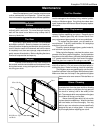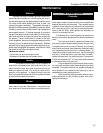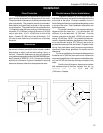
Exception TL200 Wood Stove
18
The Chimney
The Exception must be installed into a chimney
approved for use with solid-fuel appliances. In the U.S.,
the Exception must be connected to (1) a prefabricated
chimney complying with the requirements for Type HT chim-
neys in the Standard for Chimneys, Factory-Built, Resi-
dential Type and Building Heating Appliances, UL 103, or
(2) a code-approved masonry chimney with a flue liner. In
Canada, the Exception is listed for use with prefabricated
chimneys tested and listed to the high temperature (650
degrees C) chimney standard, ULC S-629, or with a code
approved masonry chimney. For mobile homes, the Ex-
ception must only be installed with prefabricated chimney
systems, including the installation components, tested to
either UL 103 or ULC S-629 which have been approved for
use in mobile homes; the diameter should match the di-
ameter of the flue collar opening.
The minimum recommended height for any chim-
ney is 16 ft (4.8 m) above flue collar height. For non-
mobile home installations, a round flue (either masonry or
approved prefabricated), of either 6" (150 mm), 7" (180 mm)
or 8" (200 mm) may be used. For square or rectangular
masonry chimneys, nominal sizes of 8" x 8" or 8"x 12"
(200 mm x 200 mm, 200 mm x 300 mm) may be used.
Codes require that solid-fuel chimneys extend 3 ft
(0.9 m) above the point at which they exit from the roof,
provided that no part of any structure is within the top of
the chimney, then the chimney must extend 2 ft (6 m)
above the highest point with the 10 ft (3 m) radius top
height. If there is not ten feet of clearance from the top of
the chimney, then the chimney must extend 2 ft (6m) above
the highest point within the 10 ft (3m) radius.
Do not connect this unit to a chimney flue servicing
another appliance.
NOTE: The restriction of not venting more than one
appliance to the same flue applies to the U.S. specifically.
While it is not recommended that you use the same chim-
ney for more than one appliance, in Canada certain ex-
ceptions may be made. Be sure to contact your building
code inspection official to see if this option is allowed in
your area, and to find out the specific requirements for
such an installation.
Venting


















